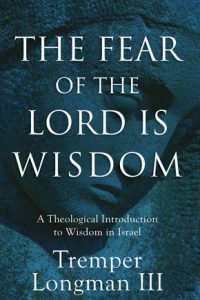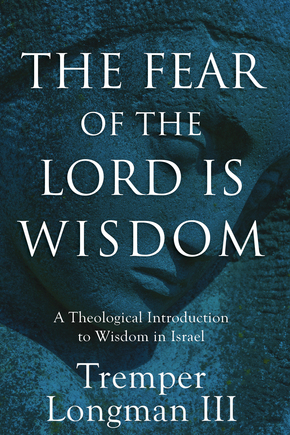Longman, Tremper, III. The Fear of the Lord is Wisdom: A Theological Introduction to Wisdom in Israel. Grand Rapids: Baker Academic, 2017. 311 pgs. $32.99.
There has long been a need for a focused, comprehensive treatment of the biblical theology of wisdom from an evangelical perspective. Tremper Longman III’s recent volume, The Fear of the Lord is Wisdom: A Theological Introduction to Wisdom in Israel, fills this void. The book focuses on the theological dimensions of the concept of wisdom as it appears throughout the Christian Bible and the Second Temple literature. The approach of the book is synchronic—it examines wisdom as a concept in the final form of the texts that we have, rather than tracing the diachronic development of the theme through Israel’s history.
The book is divided into five parts. Part one examines the corpus of books traditionally understood as biblical wisdom literature—namely, Proverbs, Ecclesiastes and Job, with Longman devoting a chapter to each. Longman surveys the literary contours of each of these books and unpacks their distinctive theological messages. These chapters provide a lucid summary of the wisdom books and lay out Longman’s approach to some of their interpretive challenges. Anyone familiar with Longman’s commentaries on these books will not be surprised at the conclusions he reaches or the points he emphasizes in these chapters. Even so, Longman makes a fresh contribution, demonstrating that these three books, through all of their distinctive concerns, present wisdom in a similar way, as having its ultimate source in God himself and as accessible to humans who fear him and humble themselves before him.
In part two, Longman examines the appearance of wisdom in OT books not traditionally included with the wisdom literature. Chapter 4 focuses on Deuteronomy, the Prophets, Psalms and Song of Songs. An important topic taken up in this chapter is the genre of Song of Songs, which Longman does not discuss alongside Proverbs, Ecclesiastes and Job in part one. Longman concludes that Song of Songs does not directly address the topic of wisdom (as do the three books in part one), though the book does, in effect, offer instruction reminiscent of that found in Proverbs regarding sexuality. Chapter 5 offers a comparison of the stories of Joseph and Daniel, who receive wisdom directly from, God, resulting in their finding favor in the courts of Egypt and Babylon respectively. In chapter 6, Longman then turns his attention to Adam and Solomon, who, in contrast to Joseph and Daniel, exemplify the abandonment of wisdom. Wisdom is not permanent, but it can be lost when one ceases to live in fearful submission to God.
Part three is perhaps the most significant section of Longman’s volume, for it is where he articulates what he considers to be the distinguishing theological characteristics of Israelite wisdom. He begins part three with a chapter on the sources of wisdom, arguing that while experience and observation have a place in acquiring wisdom, they can lead to skewed understanding and folly if wisdom is sought solely from them to the exclusion of God’s revelation. Next, in chapter 8, Longman acknowledges that wisdom entails understanding the order and function of the world. Yet, to study the world without knowing God is to be ignorant of the most profound truth undergirding the universe. Accordingly, in chapter 9, Longman contends that surrounding ANE peoples had a measure of wisdom, and this explains the similarity between some of their wisdom writings to those of the Bible. However, in not knowing or submitting to the Lord, these peoples lacked the most necessary component of wisdom in its fullest sense (p. 161). In chapter 10, Longman challenges the notion that OT wisdom is not covenantal in nature.
In part four, Longman addresses some debated issues in the study of biblical wisdom. He devotes chapter 11 to the issue of retribution theology in the wisdom literature, concluding that to pit Job and Ecclesiastes against the teaching of Proverbs is to misunderstand Proverbs. In chapter 12, he takes up the issue of the social setting of OT wisdom, concluding that the wisdom literature is likely the product of a variety of social settings. One of the most unique chapters in the volume appears in chapter 13, where Longman explores the issue of gender and wisdom, with special attention to the book of Proverbs. There, wisdom is personified as a woman before a male implied audience; in light of this, Longman takes up the question of how women can receive and appropriate the teachings of the book.
Part Five covers the presence of wisdom in the literature of the Second Temple period (ch. 14) and the New Testament (ch. 15). Among the most significant observations Longman makes about the former is that this literature makes even more explicit the connection between wisdom and revelation (particularly the Torah) already alluded to in the OT. With respect to the latter, Longman contends that the NT depicts Jesus Christ as embodying and exemplifying the wisdom of God described in the OT.
Two appendices conclude the book. Appendix 1 discusses how the modern day significance of biblical wisdom. In appendix 2, Longman weighs in on the contemporary discussion among scholars regarding whether it is proper to speak of wisdom literature as a genre. In particular, Longman responds to the recent work of Will Kynes, suggesting that “wisdom literature” remains a helpful category for classifying texts whose primary focus is the theme of wisdom.
This volume has numerous strengths and valuable insights. The scope of the book is remarkable from a biblical-theological standpoint; Longman rightly recognizes that wisdom is not a theme unique to the OT, but one that surfaces in significant ways in the NT. Longman’s discussion about the meaning of the fear of the Lord is theologically perceptive and thought provoking. The fear of the Lord as referred to in Scripture is often misunderstood. Longman clarifies that what the Bible describes is not terror that inspires retreat. Instead, the fear being referenced is more like a profound sense of “awe” that makes us tremble, for “He [God] takes our breath away and makes our knees knock together” (p. 13). Such a view of God is certainly necessary for living wisely in the world he himself made. Longman’s treatment of how the individual wise sayings in Proverbs function is perhaps the book’s most important section from a pastoral standpoint, as many in the Church today misunderstand these sayings as air-tight promises. Longman explains, to the contrary, that the truthfulness of these sayings depends on whether one applies them in the right circumstances. Additionally, I was pleased to see Longman articulate how biblical wisdom, grounded in the fear of the Lord, relates to other wisdom from the ancient Near East. Many have noted parallels between biblical wisdom and wisdom teaching from surrounding peoples, and many have noted that “the fear of the Lord” has covenantal connotations. Yet few have explained how these two aspects of biblical wisdom square with each other. Longman carefully and lucidly addresses this matter. The Bible looks favorably, to a certain extent, on the wisdom and understanding of Israel’s neighbors; however, this need not imply that the surrounding nations, who did not worship the Lord, were wise in the truest and fullest sense of the term as described in the wisdom literature. A final aspect of the book that I found to be valuable is Longman’s response to contemporary issues. Longman’s response to the question of wisdom and genre, found in Appendix 2, is one example of this; another example is his critique of the so-called “Sophia Movement,” which arises from a misreading of the references to Lady Wisdom in Proverbs 1–9.
I do not have many criticisms to offer regarding this volume. I wish Longman, in his overview of the canonical wisdom books, had interacted more with scholarship that had presented different interpretive approaches than those found in his commentaries. For example, nowhere does Longman respond to the approach to Ecclesiastes advocated by Craig Bartholomew or Ryan O’Dowd (the latter of which published a response to Longman’s treatment of wisdom in a separate volume).[1] Longman raises some significant hermeneutical questions, particularly about Proverbs, in chapter 13, where he discusses gender and wisdom. Yet, I wonder if the concerns about gender that Longman raises are overplayed at times. The personification of wisdom as an attractive woman (desirable to men) should not present much of an obstacle to female readers of the book. As Raymond Van Leeuwen has noted, the metaphor of the two paths (leading to wisdom and folly) found in Proverbs 1–9 is just as fundamental to the book’s message as that of Lady Wisdom.[2] The metaphor of the two paths is gender-neutral and readily grasped by any reader, whether male or female.
As a young scholar interested in biblical theology and the OT wisdom literature, I am indebted in many ways to Tremper Longman’s publications. Even when I am not convinced by his proposals, I always walk away from his books and articles feeling challenged and having grown in my understanding of the Bible. This book is no exception. The Fear of the Lord is Wisdom is a welcome contribution to biblical scholarship by evangelicalism’s leading wisdom specialist. The book is theologically stimulating, attentive to contemporary approaches and pastorally useful. I highly recommend this landmark volume to professors, students and clergy.
Lance Higginbotham
Trinity Evangelical Divinity School
[1] Craig G. Bartholomew, Ecclesiastes, BCOTWP (Grand Rapids, MI: Baker Academic, 2009); Ryan P. O’Dowd, “Wisdom as Canonical Imagination: Pleasant Words for Tremper Longman,” in Canon and Biblical Interpretation, ed. Craig G. Bartholomew et al., SHS 7 (Milton Keynes: Paternoster, 2006), 374–92.
[2]Raymond C. Van Leeuwen, “Liminality and Worldview in Proverbs 1–9,” Semeia 50 (1990): 111–44.





